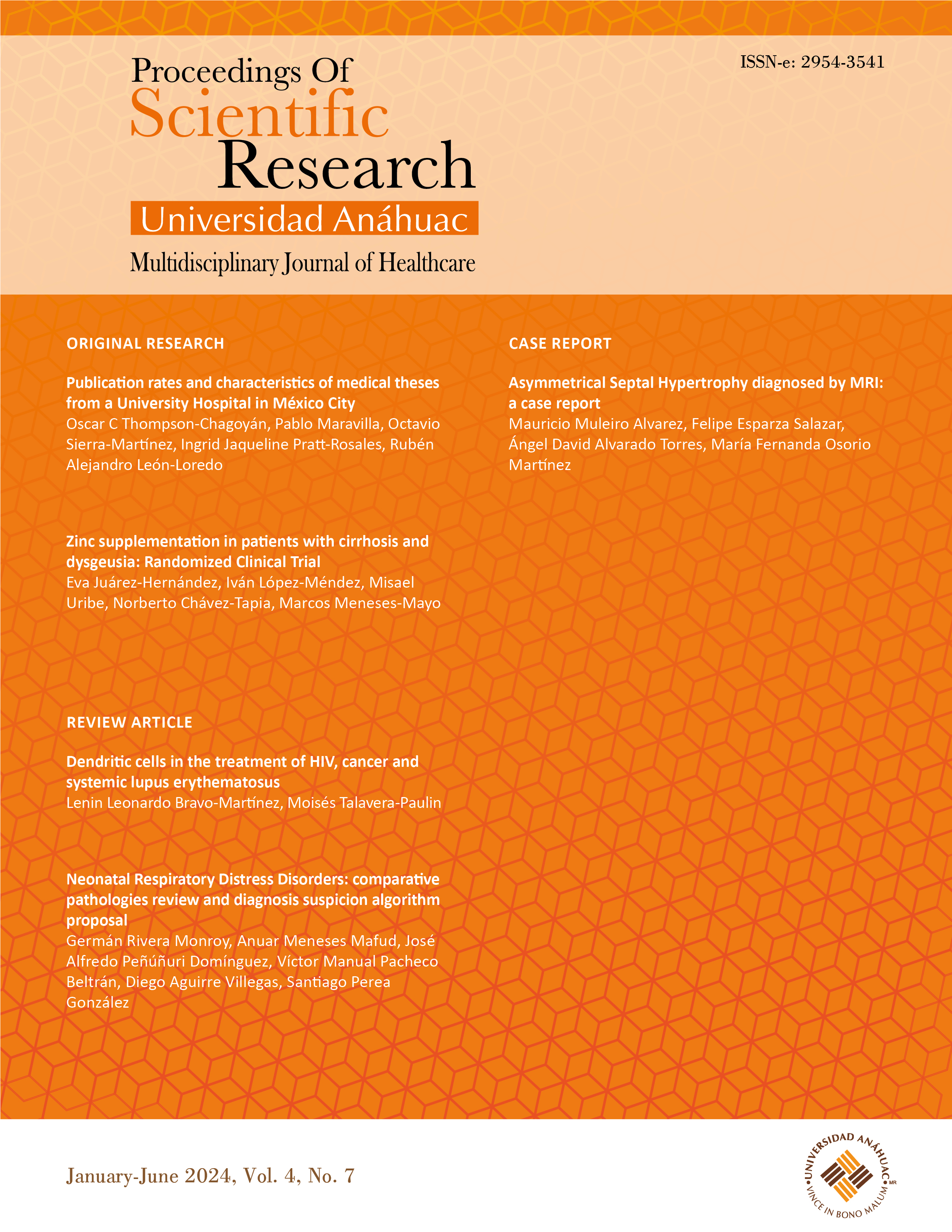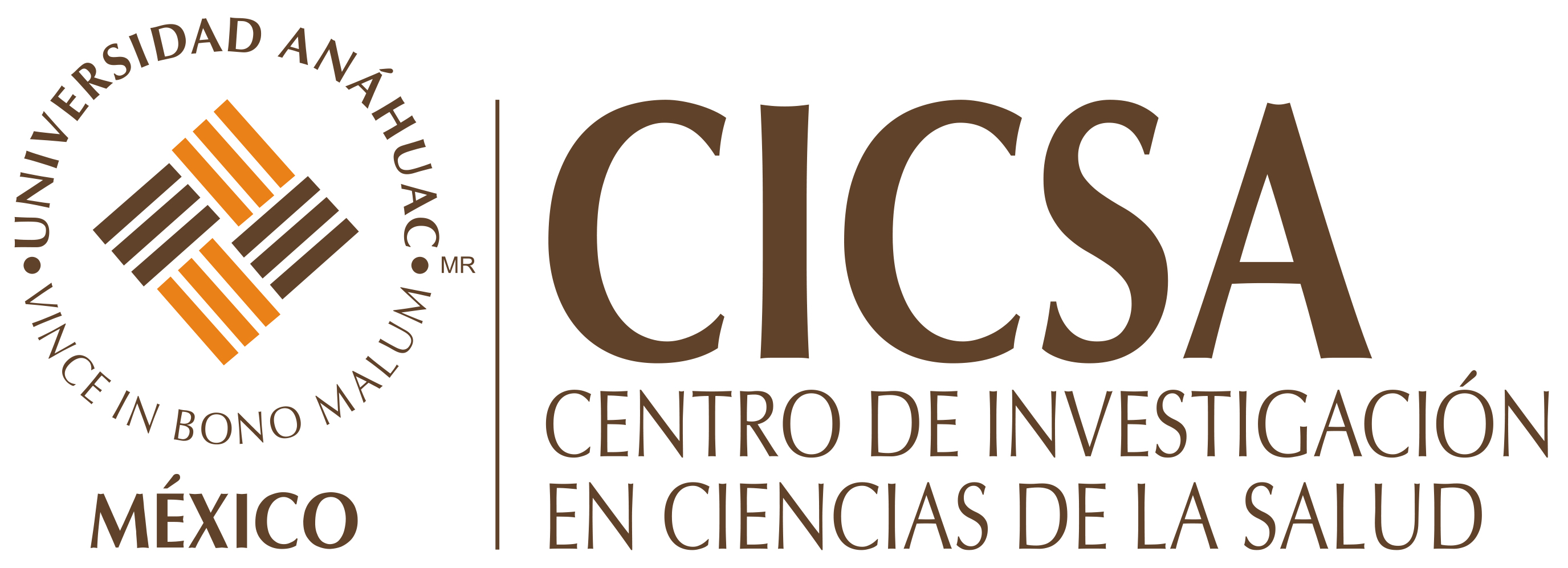Zinc supplementation in patients with cirrhosis and dysgeusia: Randomized Clinical Trial
DOI:
https://doi.org/10.36105/psrua.2024v4n7.02Palabras clave:
alteraciones del gusto, cirrosis, zinc, hígadoResumen
Antecedentes: La disgeusia se ha identificado como parte de la cirrosis hepática (CH). Ya que el zinc (Zn) está involucrado en la fisiología del sabor y la CH, el objetivo de este estudio fue evaluar el efecto de la suplementación con Zn en pacientes con CH y disgeusia. Métodos: Ensayo clínico aleatorizado, doble ciego, controlado con placebo de 34 pacientes con CH. La intervención consistió en 100mg/día de gluconato de Zinc (GZn) durante 6 meses. La mejoría de la disgeusia fue evaluada con la concentración en que se detectaron los umbrales de percepción (UP) y reconocimiento (UR) de cinco sabores. Para evaluar las diferencias, se determinaron los tamaños de efecto y la magnitud de estos con interpretación de acuerdo con los Common Language Effect Size (expresado en porcentaje) y determinando el numero necesario a tratar (NNT). Resultados: El 50% (n=17) fueron hombres con mediana de edad de 57 [IQR 51-63] años. Posterior a los 6 meses, 28 pacientes cumplieron el seguimiento; en los pacientes que recibieron Zn se observó UP a menor concentración en los sabores salado (1.0 [IQR 1.0- 14.7]M vs 12 [IQR 1.0-12]M, con una probabilidad de mejoría de 58% (NNT= 6)), dulce (1.5 [IQR 1.5-3.5]M vs 3.5 [IQR 1.5-4.0] M, probabilidad de mejoría de 57% (NNT=6)) , ácido (0.48 [IQR 0.48-0.48]M vs 0.48 [IQR 0.48-2.44]M, probabilidad de mejoría de 65% (NNT=3)) y umami (0.40 [IQR 0.40-0.40]M vs 0.70 [IQR 0.70-0.80]M, probabilidad de mejoría de 74% (NNT=2)) en comparación con el placebo. Los pacientes que recibieron Zn presentaron UR del umami en menor concentración respecto al placebo (probabilidad de mejoría 59% (NNT=5)). Conclusión: Los pacientes suplementados con GZn durante seis meses, presentan probabilidades de mejoría del UP de los sabores salado, dulce, ácido y umami mayores al 55%, mientras que la probabilidad de mejoría del UR del sabor umami es del 59%.
Descargas
Referencias
Zuñiga-Aguilar E, Ramírez-Fernández O. Fibrosis and hepatic regeneration mechanism. Transl Gastroenterol Hepatol; 7. https://doi.org/10.21037/tgh.2020.02.21 DOI: https://doi.org/10.21037/tgh.2020.02.21
Cheemerla S, Balakrishnan M. Global Epidemiology of Chronic Liver Disease. Clin Liver Dis (Hoboken) 2021; 17: 365–370. https://doi.org/10.1002/cld.1061 DOI: https://doi.org/10.1002/cld.1061
Fark T, Hummel C, Hähner A, et al. Characteristics of taste disorders. Eur Arch Otorhinolaryngol 2013; 270: 1855–1860. https://doi.org/10.1007/s00405-012-2310-2 DOI: https://doi.org/10.1007/s00405-012-2310-2
Devere R. Disorders of Taste and Smell. Continuum (Minneap Minn) 2017; 23: 421–446. https://doi.org/10.1212/con.0000000000000463 DOI: https://doi.org/10.1212/CON.0000000000000463
Bromley SM. Neurolocalization of taste disorders. In: Handbook of Clinical Neurology. Handb Clin Neurol, pp. 303–323. https://doi.org/10.1016/b978-0-444-63855-7.00019-8 DOI: https://doi.org/10.1016/B978-0-444-63855-7.00019-8
Burch RE, Sackin DA, Ursick JA, et al. Decreased Taste and Smell Acuity in Cirrhosis. Arch Intern Med 1978; 138: 743–746. PMID:646537. DOI: https://doi.org/10.1001/archinte.138.5.743
Smith FR, Henkin RI, Dell RB. Disordered Gustatory Acuity in Liver Disease. Gastroenterology 1976; 70: 568–571. PMID:1254140. DOI: https://doi.org/10.1016/S0016-5085(76)80497-0
Deems RO, Friedman MI, Friedman LS, et al. Chemosensory function, food preferences and appetite in human liver disease. Appetite 1993; 20: 209–216. https://www.sciencedirect.com/science/article/abs/pii/S0195666383710214?via%3Dihub DOI: https://doi.org/10.1006/appe.1993.1021
Henkin RI. Zinc in taste function : A critical review. Biol Trace Elem Res 1984; 6: 263–280. https://doi.org/10.1007/bf02917511 DOI: https://doi.org/10.1007/BF02917511
Henkin RI, Bradley DF. Hypogeusia corrected by Ni++ and Zn++. Life Sci 1970; 9: 701–709. https://doi.org/10.1016/0024-3205(70)90278-x DOI: https://doi.org/10.1016/0024-3205(70)90278-X
Weismann K, Christensen E, Dreyer V. Zinc Supplementation in Alcoholic Cirrhosis. A Double-Blind Clinical Trial. Acta Med Scand 1979; 205: 361–366. https://doi.org/10.1111/j.0954-6820.1979.tb06065.x DOI: https://doi.org/10.1111/j.0954-6820.1979.tb06065.x
Sturniolo GC, D’Inca R, Parisi G, et al. Taste alterations in liver cirrhosis: Are they related to zinc deficiency? J Trace Elem Electrolytes Health Dis 1992; 6: 15–19. PMID:1638179
Nagao Y, Matsuoka H, Kawaguchi T, et al. Aminofeel® improves the sensitivity to taste in patients with HCV-infected liver disease. Med Sci Monit. 2010 Apr;16(4):PI7-12. PMID:20357731
Cancer Institute N. Common Terminology Criteria for Adverse Events. In: Definitions. Epub ahead of print 2020. https://doi.org/10.32388/ERJXIQ DOI: https://doi.org/10.32388/ERJXIQ
Amerine MA, Pangborn RM, Roessler EB, et al. CHAPTER 2 – The Sense of Taste. In: Principles of Sensory Evaluation of Food. 1965, pp. 28-144. DOI: https://doi.org/10.1016/B978-1-4832-0018-7.50006-4
Detsky AS, Mclaughlin J, Baker JP, et al. What is subjective global assessment of nutritional status? Journal of Parenteral and Enteral Nutrition 1987; 11: 8–13. https://doi.org/10.1177/014860718701100108 DOI: https://doi.org/10.1177/014860718701100108
Amodio P, Bemeur C, Butterworth R, et al. The nutritional management of hepatic encephalopathy in patients with cirrhosis: International society for hepatic encephalopathy and nitrogen metabolism consensus. Hepatology 2013; 58: 325–336. https://doi.org/10.1002/hep.26370 DOI: https://doi.org/10.1002/hep.26370
Casanovas T, Jané L, Herdman M, et al. Assessing outcomes in liver disease patients: Reliability and validity of the Spanish version of the liver disease quality of life questionnaire (LDQOL 1.0). Value in Health 2010; 13: 455–462. https://doi.org/10.1111/j.1524-4733.2009.00688.x DOI: https://doi.org/10.1111/j.1524-4733.2009.00688.x
Hernández-Avila M, Romieu I, Parra S, et al. Validity and reproducibility of a food frequency questionnaire to assess dietary intake of women living in Mexico City. Salud Publica Mex 1998; 40: 133–140. https://pubmed.ncbi.nlm.nih.gov/9617194/ DOI: https://doi.org/10.1590/S0036-36341998000200005
INCMNSZ. Tablas de composición de alimentos y productos alimenticios (versión condensada 2015): huevo, gallina blanco, entero crudo., Available at: https://isbn.cloud/9786077797197/tablas-de-composicion-de-alimentos-y-productos-alimenticios-mexicanos-version-condensada-2015/ (2016, accessed 24 February 2023).
Bellisle F. Glutamate and the UMAMI taste: Sensory, metabolic, nutritional and behavioural considerations. A review of the literature published in the last 10 years. Neurosci Biobehav Rev 1999; 23: 423–438. https://doi.org/10.1016/s0149-7634(98)00043-8 DOI: https://doi.org/10.1016/S0149-7634(98)00043-8
Jáuregui-Lobera I, Bolaños Ríos P. ¿Qué motiva la elección de los alimentos en los consumidores? Nutr Hosp 2011; 26: 1313–1321.
Madden AM, Bradbury W, Morgan MY. Taste perception in cirrhosis: Its relationship to circulating micronutrients and food preferences. Hepatology 1997; 26: 40–48. https://doi.org/10.1002/hep.510260106 DOI: https://doi.org/10.1002/hep.510260106
Morando F, Rosi S, Gola E, et al. Adherence to a moderate sodium restriction diet in outpatients with cirrhosis and ascites: a real-life cross-sectional study. Liver International 2015; 35: 1508–1515. https://doi.org/10.1111/liv.12583 DOI: https://doi.org/10.1111/liv.12583
Chavez-Tapia NC, Cesar-Arce A, Barrientos-Gutiérrez T, et al. A systematic review and meta-analysis of the use of oral zinc in the treatment of hepatic encephalopathy. Nutr J; 12. Epub ahead of print 2013. https://doi.org/10.1186/1475-2891-12-74 DOI: https://doi.org/10.1186/1475-2891-12-74
Traub J, Reiss L, Aliwa B, et al. Malnutrition in Patients with Liver Cirrhosis. Nutrients 2021, Vol 13, Page 540 2021; 13: 540. https://doi.org/10.3390/nu13020540 DOI: https://doi.org/10.3390/nu13020540
Maharshi S, Sharma BC, Srivastava S. Malnutrition in cirrhosis increases morbidity and mortality. J Gastroenterol Hepatol 2015; 30: 1507–1513. https://doi.org/10.1111/jgh.12999 DOI: https://doi.org/10.1111/jgh.12999
Shiraki M, Nishiguchi S, Saito M, et al. Nutritional status and quality of life in current patients with liver cirrhosis as assessed in 2007–2011. Hepatology Research 2013; 43: 106–112. https://doi.org/10.1111/hepr.12004 DOI: https://doi.org/10.1111/hepr.12004
Rojas-Loureiro G, Servín-Caamaño A, Pérez-Reyes E, et al. Malnutrition negatively impacts the quality of life of patients with cirrhosis: An observational study. World J Hepatol 2017; 9: 263–269. https://doi.org/10.4254/wjh.v9.i5.263 DOI: https://doi.org/10.4254/wjh.v9.i5.263
Loria A, Escheik C, Gerber NL, et al. Quality of life in cirrhosis. Curr Gastroenterol Rep; 15. Epub ahead of print 1 January 2013. https://doi.org/10.1007/s11894-012-0301-5 DOI: https://doi.org/10.1007/s11894-012-0301-5
Ahluwalia V, Heuman DM, Feldman G, et al. Correction of hyponatraemia improves cognition, quality of life, and brain oedema in cirrhosis. J Hepatol 2015; 62: 75–82. https://doi.org/10.1016/j.jhep.2014.07.033 DOI: https://doi.org/10.1016/j.jhep.2014.07.033
Nishikawa H, Asai A, Fukunishi S. The Significance of Zinc in Patients with Chronic Liver Disease. Nutrients; 14. Epub ahead of print 1 November 2022. https://doi.org/10.3390/nu14224855 DOI: https://doi.org/10.3390/nu14224855

Descargas
Publicado
Número
Sección
Licencia
Derechos de autor 2024 Eva Juárez-Hernández, Iván López-Méndez, Misael Uribe, Norberto Chávez-Tapia, Marcos Meneses-Mayo

Esta obra está bajo una licencia internacional Creative Commons Atribución-NoComercial-SinDerivadas 4.0.
Todo el contenido intelectual que se encuentra en la presente publicación periódica se licencia al público consumidor bajo la figura de Creative Commons©, salvo que el autor de dicho contenido hubiere pactado en contrario o limitado dicha facultad a “Proceedings of Scientific Research Universidad Anáhuac. Multidisciplinary Journal of Healthcare©” o “Universidad Anáhuac México©” por escrito y expresamente.
Proceedings of Scientific Research Universidad Anáhuac. Multidisciplinary Journal of Healthcare se distribuye bajo una Licencia Creative Commons Reconocimiento-No comercial-Sin derivados 4.0 Internacional (CC BY-NC-ND 4.0).
El autor conserva los derechos patrimoniales sin restricciones y garantiza a la revista el derecho de ser la primera publicación del trabajo. El autor es libre de publicar en cualquier otro medio su artículo, como un repositorio institucional.














